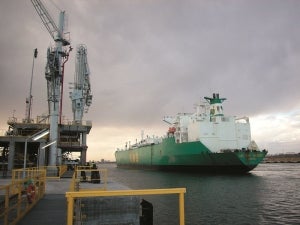
In order to better understand the consequences of an accidental liquefied natural gas (LNG) release, DNV GL has been asked to initiate a joint industry project (JIP) in collaboration with E&P companies and LNG market stakeholders. The JIP will contribute to the development of rigorous safety standards and guidelines for small-scale LNG bunkering and filling stations. Other E&P and energy companies still have time to join the project.
LNG is evolving; from large-scale seagoing vessels and large bunkering and regasification plants, towards small-scale use as fuel for road transport and short seagoing vessels. It is an attractive fuel since it offers less emissions, reduced noise levels and competitive prices compared to other conventional bunker fuel like Marine Gas Oil (MGO).
DNV GL has already made steps forward to harmonise LNG bunkering operations by launching a Recommmended Practice which provides guidance on how LNG bunkering can be undertaken in a safe and efficient manner.
Despite the well established large scale LNG market, challenges remain regarding the development of small scale LNG sector, for example: quality management, material specification, metering and sampling methods and lack of safety standards and guidelines. To address this, regulation authorities in European countries such as the Netherlands and UK are currently working on issuing standards for safe design, siting, construction and operation of LNG filling stations.
"The modelling community in Europe and risk assessment experts are uncertain about the capabilities of hazard tools in predicting LNG behaviour in the event of an accidental release of liquefied natural gas. DNV GL is therefore teaming up with industry partners to simulate several credible failure scenarios at small-scale LNG bunkering and filling stations at our Spadeadam test centre in the UK. This will generate valuable data to create well verified and approved models which accurately predict the behaviour of LNG in any type of system failure," says Mohammad Ahmad, Project Manager, DNV GL.
"This JIP will therefore contribute to the development of rigorous safety standards and guidelines for small scale LNG bunkering and filling stations," Ahmad continued.
The experiments at Spadeadam will gather data to study and understand LNG behaviour (discharge, vaporization, dispersion and flammable effects) following a system failure (puncture/rupture of a transfer hose or catastrophic rupture of a storage tank). The experimental program will also include tests of a demonstrative nature which are needed to quantify certain major hazards. The project will therefore provide information needed to carry out a quantitative risk assessment.
Industry players interested in further information about the JIP should contact:
Dr. Mohammad Ahmad
Specialist Multiphase Flow – Gas Quality and Flow
DNV GL Oil & Gas
Tel: +31507009767
Groningen, The Netherlands
E-mail: mohammad.ahmad@dnvgl.com

